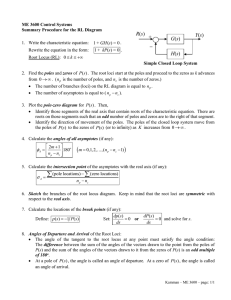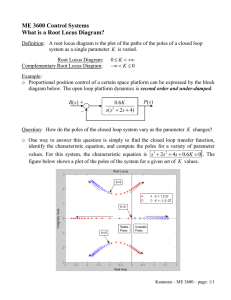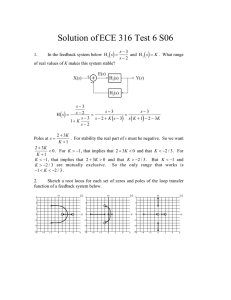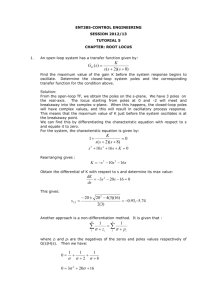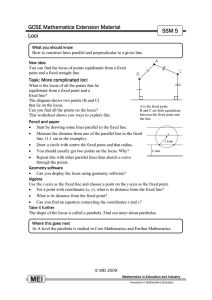Document 14436002
advertisement
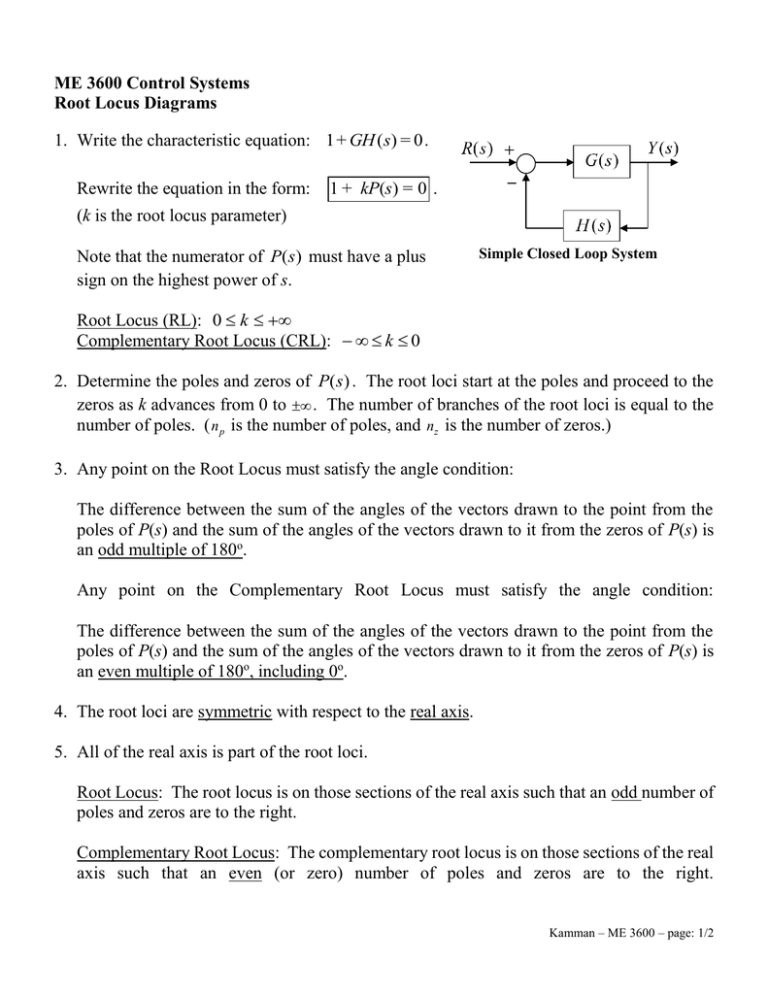
ME 3600 Control Systems Root Locus Diagrams 1. Write the characteristic equation: 1 + GH (s) = 0 . Rewrite the equation in the form: 1 + kP(s) = 0 . (k is the root locus parameter) Note that the numerator of P(s) must have a plus sign on the highest power of s. Simple Closed Loop System Root Locus (RL): 0 k Complementary Root Locus (CRL): k 0 2. Determine the poles and zeros of P(s) . The root loci start at the poles and proceed to the zeros as k advances from 0 to . The number of branches of the root loci is equal to the number of poles. ( n p is the number of poles, and nz is the number of zeros.) 3. Any point on the Root Locus must satisfy the angle condition: The difference between the sum of the angles of the vectors drawn to the point from the poles of P(s) and the sum of the angles of the vectors drawn to it from the zeros of P(s) is an odd multiple of 180o. Any point on the Complementary Root Locus must satisfy the angle condition: The difference between the sum of the angles of the vectors drawn to the point from the poles of P(s) and the sum of the angles of the vectors drawn to it from the zeros of P(s) is an even multiple of 180o, including 0o. 4. The root loci are symmetric with respect to the real axis. 5. All of the real axis is part of the root loci. Root Locus: The root locus is on those sections of the real axis such that an odd number of poles and zeros are to the right. Complementary Root Locus: The complementary root locus is on those sections of the real axis such that an even (or zero) number of poles and zeros are to the right. Kamman – ME 3600 – page: 1/2 6. Angles of Asymptotes of the Root Loci. Root Locus: For large values of k the root loci that proceed to infinity do so along asymptotes given by the angles: 2m 1 o 180 n p nz A ( m 0, 1, 2, ... , n p nz 1) Complementary Root Locus: For large values of k the root loci that proceed to infinity do so along asymptotes given by the angles: 2m o 180 n p nz A ( m 0, 1, 2, ... , n p nz 1) 7. Intersection of the Asymptotes with the real axis: The asymptotes of the root loci all intersect at a single point on the real axis. Its location is given by A (pole locations) (zero locations) n p nz Note that for complex conjugate poles and zeros, the imaginary parts cancel from the summation. 8. Break-Away (-In) Points (if any): Define: p( s) 1 P( s) Set: dp( s) 0 and solve for s. ds All real solutions are either break-away (-in) points on the Root Locus or on the Complementary Root Locus. 9. Angles of Departure and Arrival of the Root Loci: The angle of the tangent to the root loci at any point must satisfy the angle conditions in (3). At a pole of P(s), the angle is called an angle of departure. At a zero of P(s), the angle is called an angle of arrival. Kamman – ME 3600 – page: 2/2
